WEDNESDAY
FEBRUARY 27 - 2019
Marsh
or Willow Tit?
Mike Wells was
wandering along Old Liss Railway when he got a
cracking shot of a tiny bird which at first he hoped
might be a Willow Tit, but on closer inspection of the
photo he thinks Marsh Tit is more likely. I tend to
agree with him. Mike's photo is on the left below.
I know birdwatchers agonise over these two very
similar birds and I have never been certain of being
able to separate them in the field. Generally, I am
inclined to go for the more common Marsh Tit unless
there are compelling reasons to go for Willow Tit.
There are lots of subtle differences in plumage
mentioned in the bird guides though they are difficult
to see in the field with a moving bird. Having good
photos, like Mike's makes life a lot easier. One
distinguishing feature is the glossier black cap on
the Marsh Tit, which on the Willow Tit is more of a
dull matt black. The Marsh Tit also has a neater black
bib (like a Charlie Chaplin moustache) whereas the bib
tends to look fluffier in the Willow Tit. The bird in
Mike's photo has a neat glossy cap and a neat bib like
a Marsh Tit. The only 'good' possible Willow Tit I
have in my files is a photo taken by Colin Vanner in
April 2012 on Portsdown Hill - on the basis of its
general 'fluffier' appearance and its matt black cap.
Mike's Marsh Tit
is on the left and Colin's 'Willow Tit' on the
right.
Marsh Tit is a
relatively common bird in woodland and also comes into
gardens. On the other hand, Willow Tit is a scarce and
declining resident and is currently red listed for
conservation concern. The Hampshire Bird Atlas reports
very sightings and these mostly in the north of the
county around Basingstoke.
Peter's
comments
Peter Milinets-Raby refers us to a recent paper on the
latest ID criteria on Marsh and Willow Tits which
concludes that light marks at the base of the upper
mandible is the key feature in separating these
species. Only Marsh Tits have light marks on their
upper mandibles and not Willow Tits. Peter says both
the photos appear to show Marsh Tits as the birds have
light marks on their upper mandibles. I know my
eyesight is not good, but personally, I can only see
the light mark on the Marsh Tit on the left and not on
the Willow Tit on the right.
To quote from this report . . .
"Bill
marks offer the most objective and reliable visual
means of separation but may be very difficult to see
in the field or obscured on photographs and are
therefore primarily of use for birds in the hand.
Where visible, however, presence or absence of bill
marks has a very high degree of reliability on its
own".
Peter adds with less
than a dozen Willow Tits left in Hampshire learning to
separate these birds in future will get harder and
harder!
Langstone
Mill Pond
Peter
Milinets-Raby visited Langstone Mill Pond this morning
9:27am to 10:27am - low tide, lots of bright sunshine
and more heat haze making the shore very difficult to
view!!
On the pond: 8 Teal, 1 Chiffchaff heard singing -
probably not a true migrant, just a wintering bird
tempted to sing due to the wonderful weather. 1 male
Reed Bunting singing
Heronry:
Nest One: Adult feeding two fairly large young - there
could be more young as it was virtually impossible to
view this nest and there was lots of calls and the two
young I observed were not calling!.
Nest Two: Two adults present - one sat on nest - This
nest often has young early like the nest above, but
this nest is very difficult to observe due to the
foliage.
Nest Four: Adult sat firmly on nest
Nest Five: 2 adults, again seen mating
Nest Seven: Adult stood on this nest
Nest Eleven: Adult sat on this nest
Horse paddock: 9 Wigeon, 12 Teal, 1 Oystercatcher, 1
Green Woodpecker showing well enough for a photo. 5
Moorhen. 2 Jay

Off shore: 38 Shelduck
2 Turnstone 6 Golden Plover 5 Bar-tailed Godwit 14 Med
Gulls over heading inland 2 male Pintail
And in the distance on the Pook lane fields (seen
through the telescope) were 2 Cattle Egrets
TUESDAY
FEBRUARY 26 - 2019
Warblington
Peter
Milinets-Raby was out again in the unseasonably warm
weather this morning from 9am to 12:30pm - low tide
throughout and HEAT haze affecting the shoreline!!!!
Some good birds were seen this morning particularly on
the rotting hay dump in the far corner of the large
field east of the Ibis field.
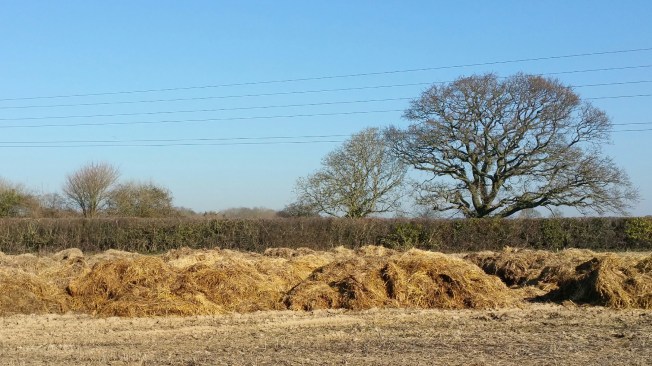
This pile provided a
wonderful pipit fest with 7 Pied Wagtails. 4+ Water
Pipits (At one stage there were 9 pipits in the air,
so 4 could have been a few more). 2+ Rock Pipits, 1
Meadow Pipit, 1 Grey Wagtail.
Peter spent ages here trying to photograph the pipits.
The Pied Wagtails were doing all the sentry work,
popping up onto the top of the piles of hay very
regularly, whilst the pipits were keeping out of
sight, using their cryptic plumage for hiding. Lots of
brief views and poor record photos taken.
Features observed on the Water Pipits (and seen in the
photos) were diagnostic white belly and under tail
coverts, greyish nape, white supercilium, dark centred
tertials and secondaries, occasionally fine off white
wing bars noted. Rock Pipits dark bellies were very
diagnostic and dirty look in general. Calls as they
occasionally flew around were subtly different. Rock
Pipit slightly more sharp and explosive and louder in
tone, than the subtle softer call note of the Water
Pipits.
Meadow Pipit . .
. Rock Pipit
Water Pipit . . . Pied Wagtail
Warblington:
Back to 5 Cattle Egrets in the field west of the
cemetery with 5 Little Egret
Ibis Field: 2 Moorhen, 1 Oystercatcher, 1
sleeping FOX.
Large field to the east: 12 Skylark, 13+ Linnets, 1
Raven over north, 4 Med Gulls over south. 1 Cetti's
Warbler singing form the hedge to the east.
A pair of Grey Wagtails on the stream by the Ibis
field. 4 Pied Wagtails and another Water Pipit on the
roughed up area caused by last years rotting hay -
very poor record photos of a greyer individual with
fine wing-bars noticeable.
Conigar Point: 2 pairs of Pintail, 1 Wigeon, 7
Shelduck, 3 Teal, 48 Dunlin, 16 Grey Plover, 1
Bar-tailed Godwit, 1 female Reed Bunting.
SSSI field. 1 male Kestrel and a male
Stonechat
Off Pook Lane: 6 Red Breasted Merganser, 46
Wigeon, 8 Bar-tailed Godwit, 67 Black-tailed Godwit
(difficult to count in the heat haze!!!), 8 Golden
Plover.
MONDAY
FEBRUARY 25 - 2019
Butterflies
What a lovely spring-like morning for a walk through
Brook Meadow. I gather the temperature reached 20
degrees in some areas of the country which is a new
all time record for February - global warming for
sure. It must have been close to that here.
The warm weather has prompted the Brimstone
butterflies to emerge from their hibernation; I
have been seeing the bright yellow males fluttering
almost everywhere for the past few days. I saw at
least 3 of them on Brook Meadow this morning, but none
of them stopped long enough for a photo. That cannot
be said about the Red Admiral that I saw
basking in the sunshine just after I had crossed the
north bridge onto Brook Meadow. Here is it.

I also saw what I am
sure was a Small Tortoiseshell fluttering
around the plants on display in Hillier's Garden
Centre at Bosham on Saturday (23 Feb), though it did
not stop for confirmation. Let's hope this predicts a
resurgence of this attractive butterfly which has been
having a tough time in recent years. I did not see any
at all last year! Here is one from earlier years.
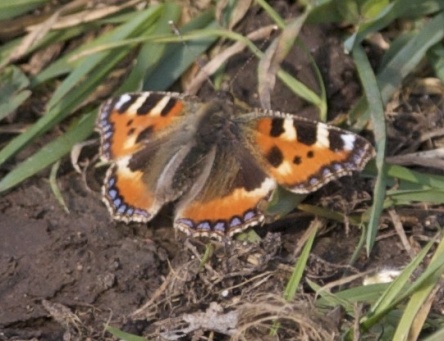
Tree
work
I met up with
local tree surgeon, Mike Reed and his young colleague
Kit, cutting down and clearing out old tree branches
in Palmer's Road Copse as instructed by Maurice
Lillie. The basic plan was to open up parts of the
copse so as to allow more light in to encourage the
growth of flora.

It was good to have a
chat with Mike who I have known for many years. He
told me he had not seen much Ash die back in this
area, but said it was rampant further north.
Mike pointed out
a large bracket fungus on a fallen Crack Willow tree
which he thought might be a Ganoderma.
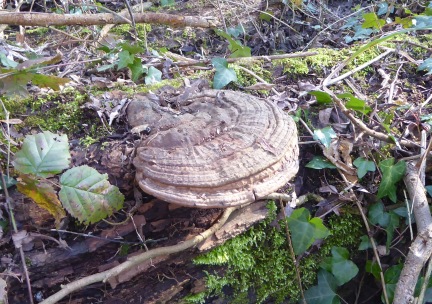
Stinking
Iris
While walking
along the Lumley Path north of Peter Pond, I stopped
briefly to take a photo of the clusters of bright
orange seeds of Stinking Iris (Iris
foetidissima) which has been growing at this
spot since at least 2003.

Although Stinking Iris
is a native plant its native range is much obscured by
garden escapes and introductions, which is presumably
how this particular plant got here. Nevertheless, one
cannot but admire the stubborn determination of this
plant to survive unscathed for so long. Stinking Iris
is a perennial highly tolerant of drought and shade,
found in hedge banks and woods, and on sheltered
scrubby sea-cliffs, mostly on calcareous substrates.
Reproduction is by seed and by rhizomatous extension.
It is mainly found in the southern part of England
south of a line from The Humber to the Mersey. It gets
its common name from its sweetly acrid smell and is
sometimes referred to as 'the roast beef plant',
though I can't smell that.
Wayside
flowers
The grassy
islands and verges at the bottom of Queen Street are
always worth checking for spring flowers. Today, I
found Ivy-leaved Speedwell and Musk Storksbill both in
flower, the latter will soon be very prominent on
these islands.
Emsworth
to Warblington
Peter
Milinets-Raby was out this morning and visited most of
the foreshore between Emsworth and Pook Lane 9am to
11:30am - low tide throughout. Here is his detailed
report of the birds seen and counted:
Beacon Square: 2 pairs of Pintail, 37 Wigeon, 1
female Red Breasted Merganser, 1 Grey Heron, 25 Brent
Geese.
Emsworth Harbour: 46 Mute Swan. 3 Turnstone, 2
Red Breasted Merganser, 22 Coot, 4 Med Gulls (with
lots of calling), 2 Lesser Black backed Gulls, 3
Black-tailed Godwit, 3 Grey Plover, 310 Brent Geese,
28 Shelduck, 6 Wigeon.
3 Greenshank including RG//- + BY//- The first
sighting of this bird for me this year).
Brian's
note on Greenshank RG+BY - This colour-ringed
Greenshank is a regular winter visitor to Emsworth
Harbour. It was ringed over 5 years ago on 19-Mar-13
by Pete Potts and his team on Thorney Island, it has
been seen regularly in Emsworth Harbour each winter
since then. It was one of the birds fitted with a
geolocator to track its movements, but this was
removed a couple of years ago. We are still awaiting
the results! Where exactly does it go in the summer? I
have seen it 6 times in Emsworth Harbour this winter.
21 Jan 2019 was the last time when I got this photo.

Mill Pond. 7
Coot. I could not find the two regular Mute Swans on
the mill pond.
Nore Barn: 1 Grey Plover, 8 male and 5 female Pintail,
10 Black-tailed Godwit, 44 Wigeon, 12 Teal, 49 Brent
Geese.
Warblington: 1 Jay.
In the second field
west of the black barn and feeding around a trailer
full of hay for the cows, were 10 Little Egret and
4 Cattle Egret It seems that we have lost one
of the Cattle Egret. Well spring is fast approaching
and these birds will disappear soon to breed -
somewhere nearby would be nice!). 40+ Redwings
also in this field with 2 Buzzards over.
Off Pook Lane:
8 male and 7 female Pintail, bringing the total
for the morning to 32.
7 Bar-tailed Godwit - the first of the year. 2
Skylarks over, 61 Black-tailed Godwit, 14 Grey Plover,
3 Red Breasted Merganser, 9 Dunlin, 45 Teal, 35
Wigeon, 239 Brent Geese, 11 Golden Plover on the
shore, 6 Little Egrets fishing in the low tide
trickle, 25 Shelduck, 1 Turnstone.
Conigar Point: 120 Brent Geese, 12 Grey Plover,
3 Dunlin, 5 Shelduck.
FRIDAY
FEBRUARY 22 - 2019
Sanderling
On Tuesday
morning Feb 19) Mike Wells managed to get his first
ever close up of a solitary Sanderling on the beach on
the Eastney side of Langstone Harbour entrance. Nice
one, Mike. Sanderling are usually seen in flocks on
sandy beaches, like Hayling, but do pop up on shingle
or even on concrete such as on the sea defences around
Southsea Castle

THURSDAY
FEBRUARY 21 - 2019
Brook
Meadow work session
I went over to Brook Meadow at 9.30am mainly to
take photos of the regular Thursday conservation work
session. A good group of 15 volunteers attended, 12 in
the photo plus Terry and Reg who were tending the
bonfire and Maurice who arrived later. The session was
led by Mike. Conditions were good for the work, cloudy
and cool and fairly dry underfoot.

The main tasks were
cutting Bramble along the paths, clearing the tangled
growth from the northern section of the hedge on the
west side of the Seagull Lane patch where Mike hopes
to continue laying the hedge and burning up all the
rubbish on a bonfire on the east side of the north
meadow. I love bonfires in winter!

For the full report
plus more photos go to . . . https://www.brookmeadow.org.uk/conservation-news/
Wildlife
observations
Lots more
fresh Molehills were along the paths on the
north meadow.
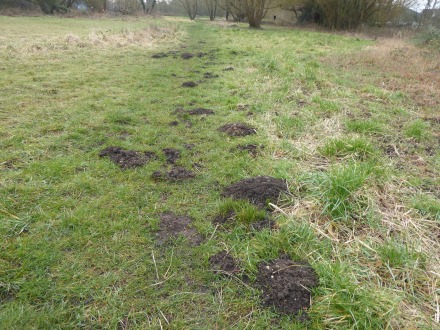
Pam Phillips reports
having seen a Water Rail just where you got
through the gate from Nore Barn Woods towards
Warblington. But she has not seen one on the River Ems
on Brook Meadow at all this winter. Dan Mortimer told
me there are two regular Water Rails on Peter Pond,
but they do not stray onto Brook Meadow. Here is one
we had on the river in the 'good old days'

Bird song on the
meadow this morning included Robin, Dunnock, Great Tit
and Wren, though I have also heard Blackbird and Song
Thrush in the past week. A pile of Woodpigeon feathers
on the grass north of the causeway is clear indication
of a Sparrowhawk kill.

The perennial
Summer Snowflake (Leucojum
aestivum) has started to bloom in the usual
place on the Seagull Lane patch near my Oak sapling.
This badly misnamed plant, which typically flowers in
later winter and early spring, is probably a garden
escape, though Summer Snowflake is a scarce native in
some areas. Here is a photo (not very good) showing
its white drooping flowers with green tipped petals.

The green flower
spikes of Butterbur are now starting to show in
the area below the main seat with one or two already
showing pink flowers. This is good to see, but they
are not particularly early as in some years I have
seen them out in January. I shall be counting them
when they are fully developed in mid March. Last year
we had over 600 spikes. See the following link for all
Butterbur counts over the last 20 years . . .
https://www.brookmeadow.org.uk/wildlife-lists/plant-counts/

There are several
clusters of Lesser Celandines in the Butterbur
area, one flower I noticed having 11 petals! The
number of petals on Lesser Celandine plants varies
between 7 and 12 (Blamey, Fitter and Fitter. p.24),
though those with 7-9 petals are the most common.

Also in the Butterbur
area is a fallen Hogweed with an attractive
flower head of pink and white flowers. That is my
gloved hand holding up the plant for a photo.

There is a nice
contrast of the white and yellow blossoms on the
Cherry Plum and Gorse on the causeway near
Lumley gate.

The young Alder
tree near the Lumley Stream is attractively
decorated with large hanging red-tinged male catkins
surrounded by clusters of bright red female catkins
which will soon develop into this year's cones.

Also present are
clumps of last year's gnarled brown cones.
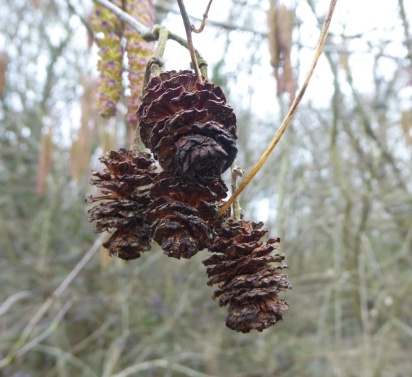
During the bonfire, we
were interested to see a small tree construction close
to the Oak tree which had an upright branch decorated
with dead grass. We thought it most likely to be the
creation of half term holiday children. Nice one.
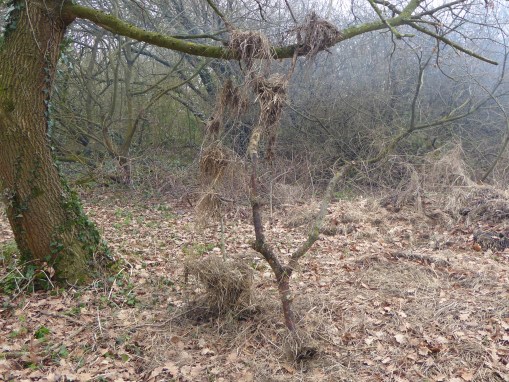
The Yew on the
east side of the north meadow has grown into a
substantial bush. It has been there for many years
though clearly has been cut back at some point to
produce a bush.

The tall stiff rounded
green leaves of Hard Rush are prominent in patches on
the centre meadow.
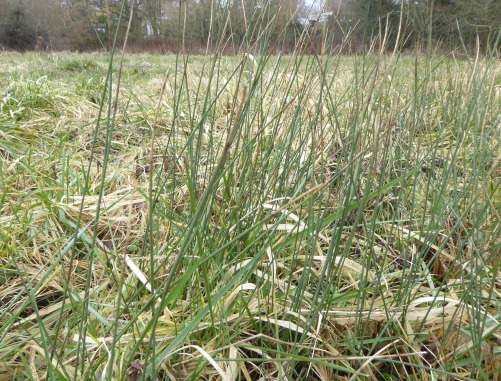
Finally, I was
interested to see that an area of the land just south
of Gooseberry Cottage, which I usually refer to a the
Lillywhite's patch as it is owned by the garage, has
recently been cleared. I wonder why this has been done
as the rest of the patch is untouched. This is where a
wonderful mass of Michaelmas Daisies grow which are an
important nectar source for butterflies and other
insects in the autumn. I trust they will grow again.

Warblington
shore
Back from his
family holiday to Barcelona, Peter Milinets-Raby just
could not wait to get back to the Warblington shore
this morning from 7:20am to 9am - low tide.
Spring has officially sprung with the sound of Med
Gulls calling. I had three birds in full summer
plumage this morning flying over Conigar Point. Great
sound!
The other highlights of the morning were as
follows:
In the field west of the cemetery were 5 Cattle Egret
with 8 Little Egrets
Ibis Field; 1 Grey Wagtail
Conigar Point: Skylark singing, 2 Greenshank, 156
Brent Geese, 9 Shelduck, 11 Dunlin, 7 Grey Plover, 2
Teal.
off Pook Lane: 213 Brent Geese, 49 Wigeon, 36
Shelduck, 13 Red Breasted Merganser, 81 Black-tailed
Godwit, 30 Dunlin, 5 Grey Plover, 75 Teal, 2 pairs of
Pintail. Two flocks of Golden Plover flew over (32 and
43 - the second flock were calling. Lovely sound). 1
Turnstone.
Langstone Mill Pond: 43 Teal, A pair of Tufted
Duck.
Grey Herons: Young heard calling from the nest at the
top of the Holm Oak. Two adults observed mating on
another nest and an adult was sat very tight on eggs
on another nest.
Horse paddock: 1 Green Sandpiper, 1 Jay.
Peter's
Spanish birds
Peter attached
a selection of photos from his holiday to Barcelona
which he thought we might like to see.
Blue Rock Thrush,
Rock Dove, Serin and Chough.
Griffon Vultures and
Monk Parakeets
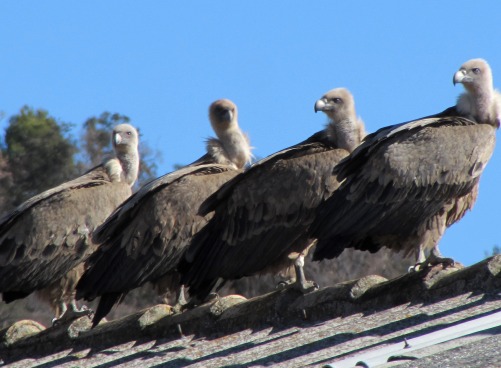
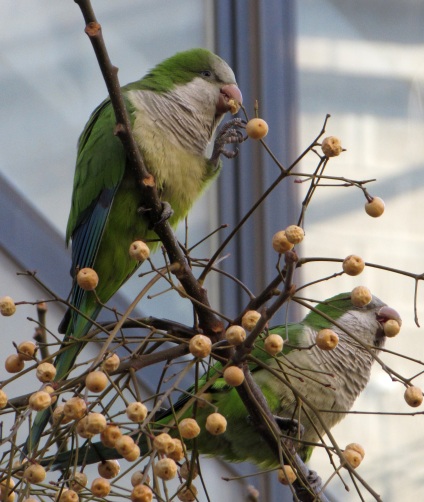
Peter's best bird of
the holiday was got when he visited the craggy hills
around the village of Alquezar to celebrate his 60th
birthday. It was there he managed to get photos of a
Wallcreeper which was in his words . . . "a
bird I had yearned to see from the very first time I
was given my first pair of binoculars when I was one
year old!" (Joking) He saw the bird from the balcony
of his apartment in Alquezar - "probably the best
balcony in the World".

SATURDAY
FEBRUARY 16 - 2019
First
Blackbird song
I heard my
first Blackbird song of the year from the near the
southern entrance to Bridge Road car park at 5.30pm
this evening. Another one was singing from a garden in
St James Road. This song is my favourite (apart from
Nightingale). It will be singing where you are. Listen
out at dusk for this beautiful song so rich and
relaxed in delivery.
I usually hear my first Blackbird song at this time of
the year - in fact, this was the exact date that I
heard my first one last year also in Bridge Road. It
always interests me how birds of a species all tend to
start singing at the same time. Here is a shot of a
Blackbird singing at this time of the year taken from
my files.
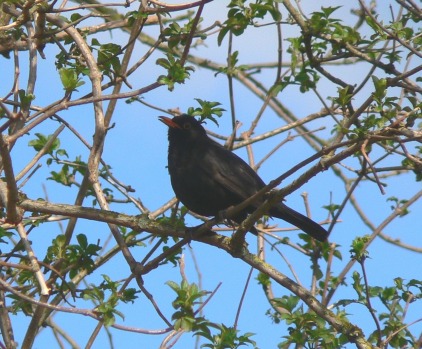
Chidham
Ros Norton
reported on this morning's walk by the Havant Wildlife
Group :
A group of twelve met at Chidham car park for a walk
south to Cobnor Point on an overcast but mild day. We
heard a wren and skylarks singing also a robin and
yellowhammer. It was soon after high tide and a good
number of brent geese were seen in the harbour. Other
birds included a little egret, curlew, redshank,
mallards, shelducks, crow, kestrel , magpie,
stonechat. A large number of wood pigeons were sharing
a tree and a rabbit was seen.
Male and female
Reed Buntings
Around the Activities
Centre we saw a goldcrest, blackbirds, green
woodpecker, blue and great tits, a black tailed
godwit, another curlew and more brent.
We heard chaffinches ,
greenfinches and the drumming of a greater spotted
woodpecker. Further south towards Cobnor Point we saw
greenshank, turnstones, black backed gull, herring
gulls, common gulls and black headed gulls. There was
a large number of dunlin, 3 mergansers, cormorants,
rock pipits, teal, wigeon, lapwings, and grey plover.
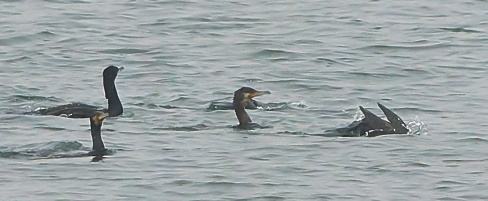
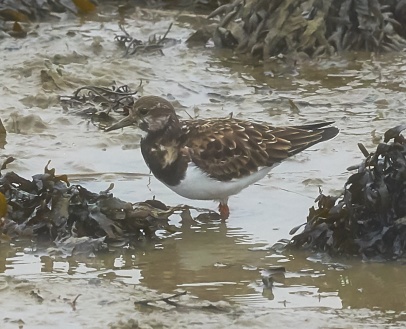
Flowers included
butchers broom, winter heliotrope, annual mercury,
gorse, daisy , dandelion, mayweed, a yellow crucifer,
groundsel ,field speedwell, red deadnettle, ,primrose,
snowdrops . We noticed the small red female catkins
near the dangling male catkins on some hazel
bushes.
THURSDAY
FEBRUARY 14 - 2019
Southsea
It was such a
lovely morning that Jean and I decided to have a walk
along Southsea promenade from the miniature golf
course to the Castle. Passing Canoe Lake, we were
interested to see a good flock of over 50 Mute Swans
on the lake. This reminded me the time (from 1996 to
2005) when I used to carry out regular swan counts on
the lake. My record count was 84 in Year 2000, though
numbers had dropped dramatically by year 2005 at which
time the Council were actively discouraging residents
from feeding the swans. See details of these early
swan counts at . . . Canoe
Lake, Southsea
Far more dramatic than
the swans was the large flock of Brent Geese
that we watched swirling around in the sky over
Eastney. Later, walking back to where we had parked
the car, we found them feeding on the grass of
Southsea Cricket Field. This is a favourite spot for
Brents and I have often seen them here in previous
years. I did not attempt to count them today, but I
would estimate the flock as about 700 birds. Very
impressive.
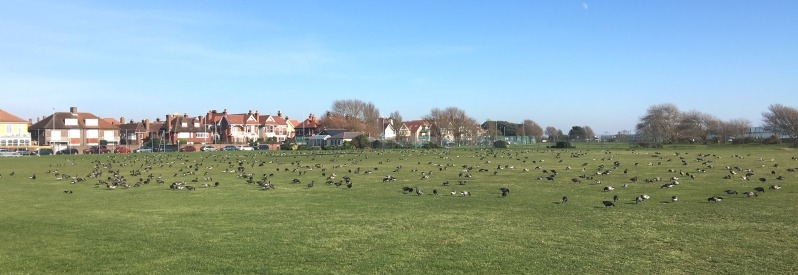
WEDNESDAY
FEBRUARY 13 - 2019
Nore
Barn
It was a
lovely afternoon, so I nipped over to Nore Barn to do
a bit of birdwatching. I arrived at 3pm with the tide
already well advanced - 2 hours to high water. The
Spotted Redshank was present in the stream
though it was scared off temporarily by a boisterous
dog just as it was getting attention from two guys
with big cameras. I told them it would come back and
it did. With 15 years experience under its feathers,
our Spotted Redshank is not fazed by silly dogs.
Here's a shot I took of our famous bird basking in the
late afternoon sunshine as if nothing had happened!

The creek south of the
woods was full of with Brent Geese, Wigeon, Teal and
Black-tailed Godwits taking advantage of the last
remaining mudflats.

I counted 64
Black-tailed Godwits feeding along the edge of the
shore, with much 'spurting' in evidence. I spotted
just one colour-ringed bird: W+WN - This has
been a regular wintering Godwit in Emsworth for the
past 8 years, today's being the 70th sighting. It was
originally ringed by Pete Potts and his team on
05-Sep-10 at Farlington Marshes.

Garden
Blackcap
I just
happened to be looking at of the window onto the back
garden at the right time today to see my first
Blackcap of the winter - a female feeding on the fat
balls. It stayed just long enough for me to get the
camera out for a quick snap through the window. You
can just see its brown head behind the fat
balls.
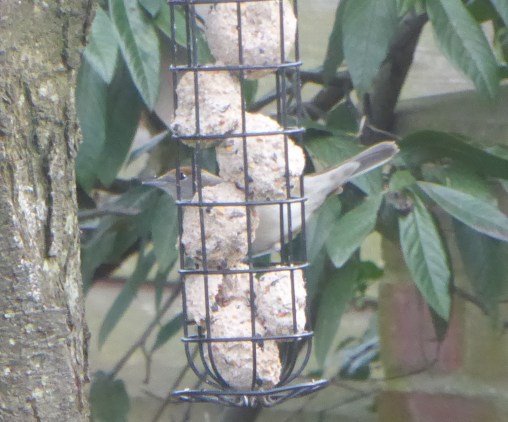
My last garden
Blackcap sightings were a male female pair in Feb last
year. Blackcaps are, in fact, regular visitors in my
garden in Feb-Mar, though you have to be quick to spot
them! Wintering Blackcaps are migrants from the
continent and are a different population from the
summer visitors which travel here from the
Mediterranean and Africa.
TUESDAY
FEBRUARY 12 - 2019
Short-eared
Owl at Thorney
Anne Moodie
wrote to say she has often looked at the photos of
Short-eared Owls on this blog in awe, but today during
a very muddy walk down the east path of Thorney, she
saw one for herself and got a couple of cracking
photos too boot.
Kingfishers
in Emsworth
We are very
fortunate here in Emsworth to be able to get good
sightings of Kingfishers on the river or over the
millponds throughout the winter period. We often get
no more than a blue flash as the bird flies up the
river or a distant view of one flying low over the
surface of one of the millponds. However, while
walking round the Slipper Pond this morning David
Perks was lucky to see a Kingfisher perched on one of
the boats in the channel behind Slipper Mill. He also
saw one last week on the Lumley Stream near the
entrance to Brook Meadow. David did not get a photo,
so here is one of a female Kingfisher (with red lower
mandible) from my files taken by Malcolm Phillips a
few years ago perched on a wall overlooking Dolphin
Lake.

MONDAY
FEBRUARY 11 - 2019
Nore
Barn
Jean and I
walked to Nore Barn and back along Western Parade and
round the millpond this morning in very pleasant
winter weather, chilly, but not over cold or windy.
The tide was well out, so there was no chance of the
Spotted Redshank in the stream. The main channels were
lined with Brent Geese, gently grunting in
communication. It was good to meet up for a chat with
my old friend Dave Mead who was walking from Prinsted
to Nore Barn. That's a fair old walk! We commented on
the Brent Geese assembling in readiness for
migration.
At about 11.30, from the millpond seawall I spotted a
tell-tale flock of c50 Black-tailed Godwits on
the mud bank on the edge of the main channel. That's a
popular spot for them to rest on a rising tide before
flying off to roost. A passer by asked if they were
Dunlin, an easy mistake to make with the naked eye.
Here is a shot I
got of the Godwits with my small Sony camera.
Peter Milinets-Raby saw the same Godwits a couple of
hours earlier - see his report below.

Emsworth
- Warblington
This morning
Peter Milinets-Raby was also at Emsworth Harbour from
9am to 10am and later at Warblington Farm. Low tide
throughout.
Beacon Square: 83 Brent Geese, 2 Shelduck, 11 Wigeon,
1 male, 1 female Pintail, 8 Dunlin, 1 Grey Plover, 1
Lesser Black-backed Gull.
Emsworth Harbour: 10 Wigeon, 5 Turnstone, 5 Grey
Plover, 1 male Gadwall, 51 Black-tailed Godwit, 3
Greenshank, 7 Lapwing, 3 Little Egret, 18 Coot -
numbers well down on last week? 1 Grey Wagtail heard.
30 Mute Swan, 21 Shelduck, 3 Little Grebe, 396 Dunlin,
1 Skylark heard passing over singing!!
Mill Pond: 7 Coot and 2 Mute Swan.
Nore Barn: 6 male and 4 female Pintail, 1 Black-tailed
Godwit, 60+ Wigeon.
10:05am to 10:20am
Warblington, Castle Farm: Still 5 Cattle Egret with 9
Little Egrets in the field west of the cemetery (Just
took a few photos - too bright, so I did not stay).

Hedgehog
out!
Caroline
French reports seeing a hedgehog in her North Emsworth
garden over the past two nights. Last night it was
tucking into the food Caroline had put out in the
feeding station, seeming to have had a good feast! Has
anyone else seen Hedgehogs out this winter?
SUNDAY
FEBRUARY 10 - 2019
Brook
Meadow
The highlight
of this afternoon's breezy walk through Brook Meadow
was a Song Thrush in full song high in a Crack
Willow tree near the north bridge. I got a few shots
of it and a video clip. Sorry about the wobbles, but
it was very windy! Other birds in song were Robin,
Wren, Dunnock, Great Tit and House Sparrow
(chirruping). Spring is on the way!

Video clip of the Song
Thrush . . . https://youtu.be/16IqVtmkUk8
The flowers on the
Cherry Plum tree on the causeway are opening
well; in a few weeks time the tree will be a blaze of
white blossom.
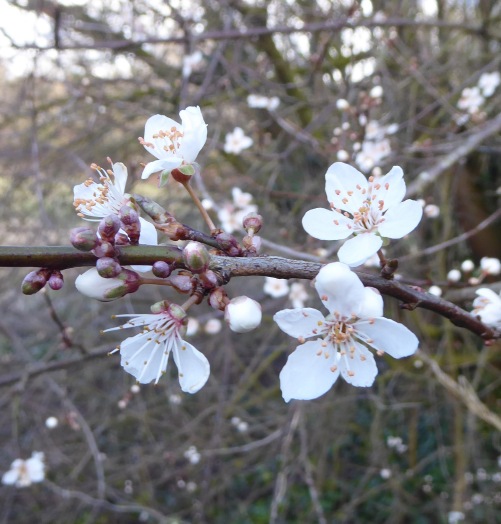
SATURDAY
FEBRUARY 9 - 2019
Emsworth
Harbour
I had a breezy
walk around the town millpond this morning. Nothing
special to report on the pond, but I was pleased to
see a good flock of Brent Geese feeding fairly
close to the seawall at high water. These birds could
be assembling in preparation for migration - yes
winter is nearing an end, for them at least!

I counted 40 Mute
Swans in the harbour, mostly near the town. This
is the same number that Peter Milinets-Raby had on Jan
28 and probably indicates that these birds have
decided to stay for a while. I would like them move
onto the millpond in force to reclaim the territory
from the resident pair that have aggressively driven
off all intruders over the past few years. But I know
it wont happen because swans just do not act in unison
like an army!

Nutbourne
Heather Mills reports on this morning's walk by the
Havant Wildlife Group Eight met on a blustery morning
which was set to intensify as we ventured along the
shoreline.

However, not before we
saw 3 welcome Common Snipe in the field
alongside the footpath.
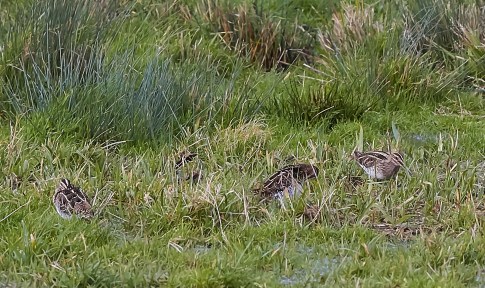
Teal and numerous
Moorhens with a few Mallard around the vicinity of the
stream. A male Green Woodpecker constantly
called and we later got lucky in seeing it descend
from the distant dead tree, choosing a tree trunk
fairly close-by in the neighbouring old orchard, with
a possible female in attendance which quickly
disappeared.
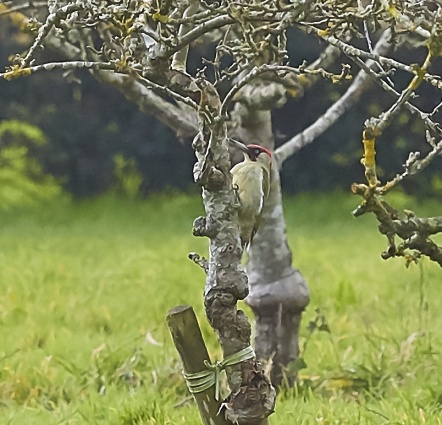
As we assembled at the
head of the footpath overlooking the outgoing tide, a
flock of Avocets approximately 30 plus counted
by Caroline, were seen at the water's edge.
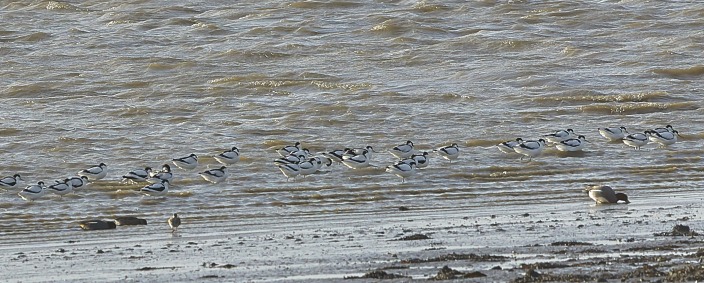
A Curlew and a few
Redshank with Grey Plover and also Wigeon, Brent and a
small flock of Pintail were seen. Caroline also noted
the first of many Ringed Plover which flew in as we
ventured to go in an easterly direction for a change.
Dunlin flocks and Oystercatchers also seen with more
Grey Plovers. Unfortunately due to the gusty
conditions we made a decision to retrace our steps.
This was the first time we have curtailed one of our
walks due to prevailing conditions. A Meadow Pipit and
probable Skylark flew across and about 20 Lapwing took
to the sky as we turned around. We retraced our steps
to go westward along the footpath into the orchard
area. Hearing the many House Sparrows hereabouts is
always welcome. Soon settling to have a welcome coffee
and catch up with a calling Great Spotted
Woodpecker
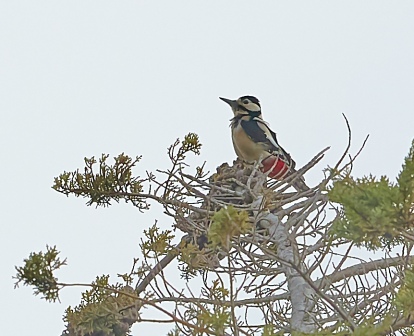
, and numerous calling
Great Tits with a lone Song thrush, intermittently
singing in a Lombardy Poplar. A Kestrel settled on a
stump of a dead fir tree in the distance. Plants seen
Gorse, Annual Mercury pointed out by Ros and Red
Deadnettle. And Snowdrops.
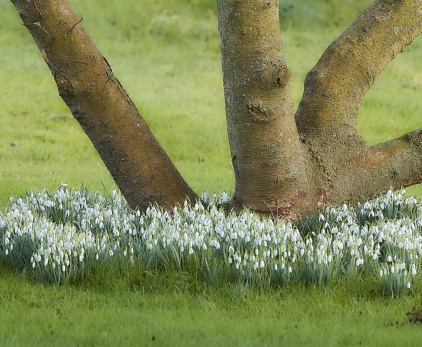
News
from Cuba
Malcolm
Phillips and his wife Barbie had a ride on the local
train, not the most comfortable but it got them to the
swamps. Malcolm was pleased to get a White Ibis (a
first for him) and a Black-necked Stilt in the same
picture.

Malcolm also got an
Royal Tern in flight - a winter visitor to Cuba and
the Southern USA.

FRIDAY
FEBRUARY 8 - 2019
Hermitage
Millponds
Storm Eric
made walking quite a struggle this morning on the way
to the Hermitage Millponds. When I got to the ponds, I
had a job standing up, let alone keeping the camera
still. On Slipper Millpond, I managed to get a hazy
snap the pair of Great Black-backed Gulls, that I
first saw yesterday on the raft, riding out the storm
on the choppy waters of the pond. They are clearly
here to stay!

Meanwhile, the
resident Mute Swan pair are back on their favoured
nesting territory on Peter Pond alone, having finally
driven off their remaining cygnets from last year's
brood.

Langstone
Mill Pond
Peter
Milinets-Raby managed to get to Langstone Mill Pond
this morning between storm Eric's reign of wind and
rain - 9am to 10am - low tide. The strong wind had
certainly affected the numbers of birds and wader
numbers were down to almost zero. Even the Brent Geese
were elsewhere!
Off shore: 23 Black-tailed Godwit, 1 Greenshank -
usual ringed bird G//R + BR//- feeding in the outflow
stream with a Little Egret. 1 Lapwing, 59 Teal, 6
Common Gull, 75 Shelduck, 1 male Shoveler, 2 Red
Breasted Merganser braving the choppy channel, 11
Dunlin, 2 Grey Plover, 93 Brent Geese.
On the pond: 2 Teal with a pair of Tufted Duck.
Flooded horse paddock: 9 Stock Doves, 40 Teal, 5
Little Egrets, 1 Buzzard - the regular pale bird.
THURSDAY
FEBRUARY 7 - 2019
Great
Black-backed Gulls
return
I had an afternoon walk down to Slipper Millpond where
I found the pair of Great Black-backed Gulls on the
centre raft - making an early claim to their preferred
nesting site which for the past 2 years has been
occupied by Canada Geese.
This pair of Great Black-backed Gulls has nested on a
raft on Slipper Millpond every year since 2012 - so
this could be their 8th year. The Sussex Bird Report
for 2017 describes Great Black-backed Gulls as 'mostly
non-breeders, but very scarce breeder since 2000' Only
three pairs were confirmed to have bred in the county
in Year 2017. So, they clearly do not have the Slipper
Millpond records! This omission needs to be rectified
as Slipper Millpond is just over the border in West
Sussex. Note sent to John Newnham at SOS
Great
Black-backed Gulls return to their nesting raft on
Slipper Millpond - 7 Feb
2019
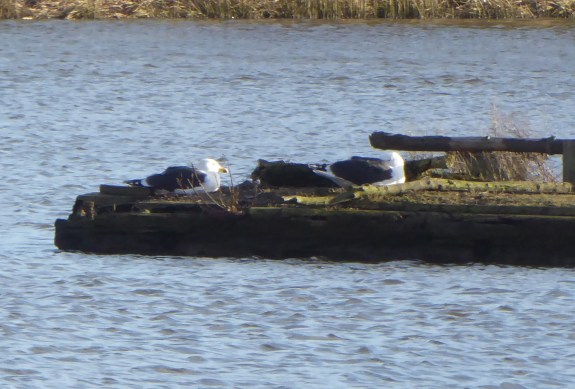
For
the full history of nesting of these birds on Slipper
Millpond go to . . .
Great
Black-backed Gulls on Slipper Millpond
TUESDAY
FEBRUARY 5 - 2019
Warblington
shore
Despite the
light dusting of misty rain drops and the cool
temperatures and chilly wind, Peter Milinets-Raby
ventured down to the Warblington shore to catch the
incoming tide (9am to 10:30am):
Five Cattle
Egrets!
In the field to the west of the cemetery there was an
150% increase in the population of Cattle Egrets!!
From two to five! They were a bit nervous and spooked
many times with all the heedless visiting birders with
their "lets walk boldly up to this chap hiding behind
a tree with his telescope out, standing very close to
them" attitude. I managed to get a few good photos,
but had to give up in the end as the disturbance was
just too much, plus, I really wanted to count the
shore before the tide rushed in! The three new Cattle
Egret arrivals only had hints of an orange wash on
their foreheads. The two resident birds were now
getting very orange!! Also in the field were 3 Little
Egrets and a male Pheasant.
Other
sightings
Conigar Point: 292 Dunlin, 10 male and 10 female
Pintail - some lovely views (A new maximum count for
February), 63 Wigeon, 6 Red-Breasted Merganser, 41
Grey Plover, 304 Brent Geese, 22 Teal, 58 Shelduck, 1
Turnstone, 3 Meadow Pipits over.
Two flocks of Black-tailed Godwits flew out from Nore
Barn and flew south west to Hayling (35+ and 45+). 1
Kingfisher dashed low across the water heading south
to Hayling Island
Off Pook Lane - tide in too much, so nothing to count:
A pair of Goldeneye, 1 Red Breasted Merganser, 70
Lapwing, 47 Wigeon, 32 Shelduck.
MONDAY
FEBRUARY 4 - 2019
Colour-ringed
Godwits
For the
records I think we have finally cracked the
colour-ringed combinations on the Black-tailed Godwits
that Christopher Evans saw at Hayling Oysterbeds on
Jan 31. They are L+LO and L+WL. Both were ringed by
Pete Potts and his Farlington Ringing Group on at
Farlington Marshes: L+LO on 10-Sep-09 and L+WL
05-Sep-10. Pete's records indicate that both birds
have been sighted many times, mostly in the
Langstone/Hayling area and not in Emsworth.
Photo
- Black-tailed Godwit L+LO (L ring looks yellow due to
staining). L+WL
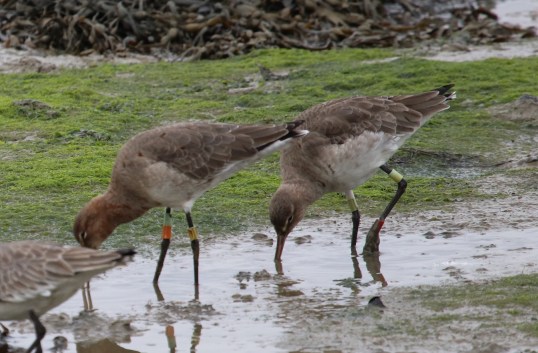
SUNDAY
FEBRUARY 3 - 2019
Brook
Meadow Workday
It was a
bright and crisp winter morning for the work session
attended by 7 volunteers and led by Maurice.
Volunteers donned their new bright yellow high
visibility jackets before setting off for work. I got
into the group photo for a change by resting the
camera on a wheelbarrow and setting it on the 10 sec
timer. I am the one without a yellow
jacket!
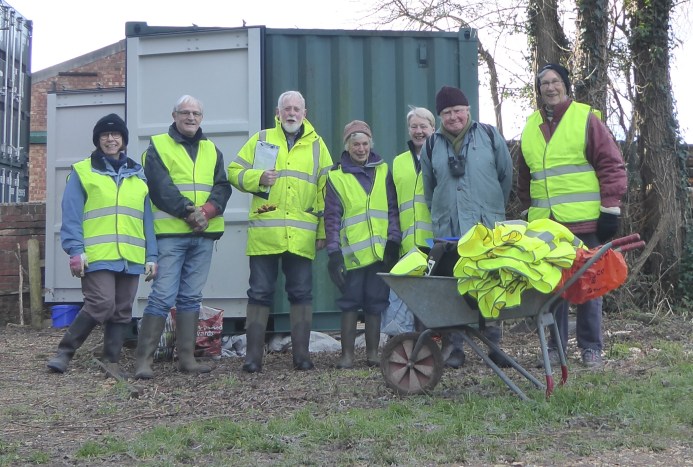
The main task was to
make a bonfire to burn up the brambles, twigs and
small branches that had been cut in previous sessions.
Debbie and Kathy were in charge of the fire which was
rather slow to get going due to the damp materials,
but it was good to feel the warmth of the fire on this
cold morning.

A view of the meadow
from the main seat.
Volunteers just visible behind the trees

For the full report
and more photos please go to . . . https://www.brookmeadow.org.uk/conservation-news/
Wildlife
observations
Robin and
Great Tit were singing well around the meadow during
the work session while a Green Woodpecker was
constantly yaffling from the east side of the north
meadow.
I noted a good number
of fairly fresh Molehills around the meadow.
Although Moles dig actively throughout the year, once
a Mole has established its burrow system, there may be
little evidence above ground of its presence. However,
they usually become more active during periods of
frost and snow, when the newly dug tunnels act as food
traps for invertebrate prey such as earthworms and
insect larvae. Molehills also become prominent during
the Mole's breeding season when males greatly extend
their tunnels.
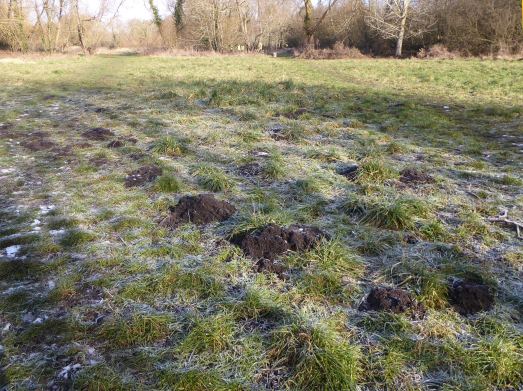
Jennifer Rye's
grandson Eric showed me a compressed bunch of Burdock
burrs which I guess is due to human intervention
rather than nature though I could be wrong. Any other
ideas?
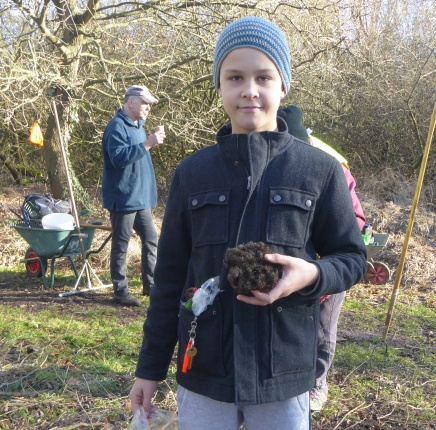
News
from Cuba
Malcolm
Phillips, ex Brook Meadow star photographer, is now
living in Cuba with his wife, Barbie. He apologises
for the long delay in getting in touch but he's had no
internet connection. But he's back on now and is still
using his camera to good effect. He sent two good
shots that he got within half an hour to share with
us. First was an American Kestrel which hovered over
the garden showing off its wonderful russet tail. And
then came a Peregrine Falcon which Malcolm says is a
rare sighting in this area. What a pair of beauties.
Well done Malcolm.
SATURDAY
FEBRUARY 2 - 2019
Fighting
Egrets?
Neil Scott
sent me a fascinating set of images showing of a pair
of Little Egrets apparently fighting at mid-morning
today at the southern end of Slipper Millpond. Or is
this courtship display?
I personally have not seen this aggressive behaviour
before in Little Egrets, though I do wonder if it
could account for the dead Little Egret that I found
in the stream at the bottom of my garden (see photo on
blog for Sunday 27 Jan). I gather it is not uncommon
for Little Egrets to squabble in nesting colonies, but
outside of nesting it is very unusual. Has anyone else
seen this behaviour?
Garden
Chaffinches and Greenfinches
Sue Thomas was
surprised and delighted to see both Chaffinches and
Greenfinches in her Westbourne garden today and sent
me photos of both. For the past 2 or 3 days Sue says
there has been up to 5 Chaffinches at one time, 2
males and 3 females. What a lovely shot of two of them
with Snowdrops in the background.
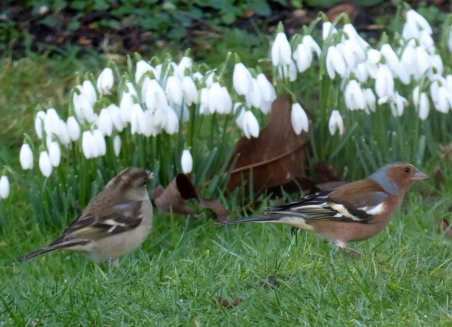
As for Greenfinches
Sue has not seen them in her garden for about 2 years
until today when two were present. One Greenfinch
managed to get on the feeder, but the second one clung
to a nearby twig with its beak open as if asking to be
fed. That does not sound too good to me.

These two birds used
to be very common garden birds across Britain until
around 2008 when their populations crashed due mainly
to the disease trichomonosis - confirmed by BTO Garden
BirdWatch. This dramatic decline also happened in my
own garden near the centre of Emsworth where
Greenfinch was my number one garden bird until 2008
with up to 40 birds being present. They were costing
me a fortune in sunflower hearts as they would not
touch anything else! But now even one is a rarity -
the last Greenfinch I saw in the garden was in June
last year. The following chart shows their dramatic
decline in my garden over the years which shows no
sign of recovery.
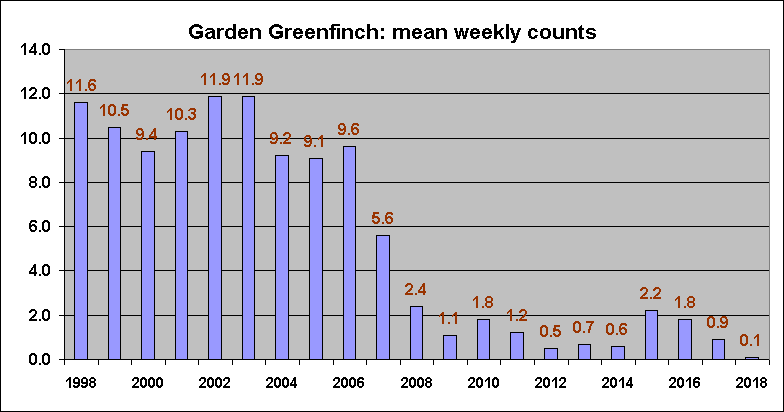
Chaffinch has shown a
similar decline in my garden since 2008 though not
quite as dramatically as Greenfinch. I still see one
or two occasionally, but they are far from common. It
is not unusual for Chaffinches also to have a white
crust on their legs and feet, though I gather this is
not fatal as it does not restrict feeding as does
trichomonosis.
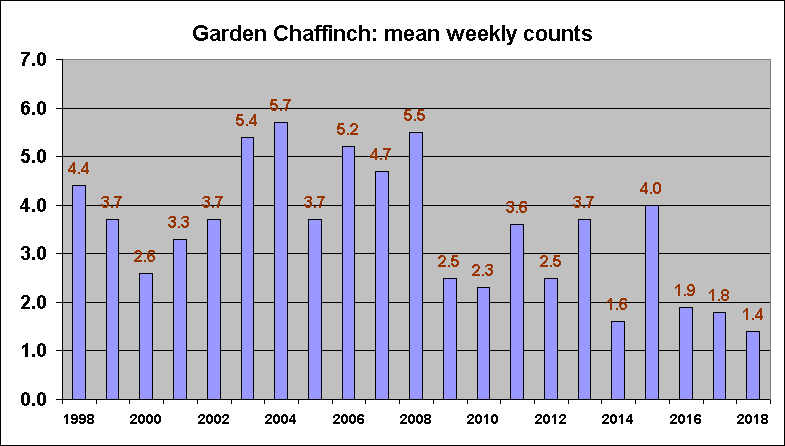
Colour-ringed
Godwits
Here is the
latest update on the colour-ringed Black-tailed
Godwits seen by Christopher Evans at Hayling
Oysterbeds on Jan 31. Pete Potts informs me that the
Godwit Y+LO is in in fact L+LO. The left lime ring has
become stained an orange colour, probably from irony
deposits in Icelandic pools. Black-tailed Godwit L+LO
is the bird on the left in the photo. The other one is
W+WL (I think).

FRIDAY
FEBRUARY 1 - 2019
Langstone
to Emsworth
Peter
Milinets-Raby walked from Langstone to Emsworth this
morning counting birds as he went. I was delighted to
meet up with him as I was walking round the town
millpond. Peter was standing on the seawall scanning
over the harbour with his scope and he showed me a
distant Peregrine perched on a red marker post in the
harbour. He also pointed out a female Kingfisher
perched on a garden wall overlooking the millpond - to
the utter delight of a couple of passers by who had
not seen a Kingfisher for 20 years!
Here is Peter's
photo of the Kingfisher
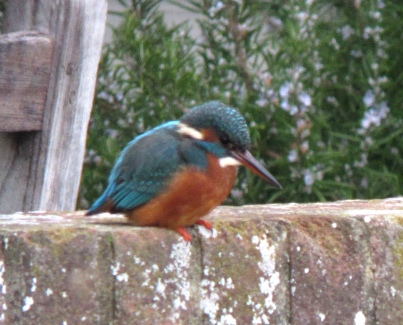
Here are the details
of Peter's outing. High tide throughout, slowly
dropping. Surprisingly little snow left and quite
mild.
Langstone Mill Pond (9:05am to 9:54am). 66 Teal, 1
Little Egret, No sign of the Canada Goose. Has it
gone?
Paddock: 1 Oystercatcher, 1 Buzzard.
Off shore: 338 Brent Geese, 23 Shelduck (Feeding along
the Hayling shore, the bulk of the birds had drifted
off Conigar Point - see below). 4 male and 1 female
Shoveler, 64 Wigeon, 5 Lapwing.
Off Conigar Point: 112 Shelduck (A new record count.
The birds were in a loose flock resting on the water
drifting east with the receding tide). 111 Wigeon, 1
Great Crested Grebe, 12 male & 5 female
Pintail.
Nore Barn (10am to 10:22am): 174 Wigeon (A new maximum
for February for this site).
716 Brent Geese (A great count for Nore Barn - alas
most were feeding in the salt marsh, so I was really
just counting head and necks, so the Light-bellied
bird could easily still be around). 7 male & 1
female Pintail - not the numbers I was expecting after
my last visit! 25 Shelduck, 40 Teal, 1 Spotted
Redshank.
Beacon Square: 7 Shelduck, 1 Lesser Black-backed Gull,
78 Knot (first of the year - feeding on the edge of
the salt marsh, distant), 120+ Dunlin, 4 Grey
Plover.
Emsworth Harbour (10:24am to 11:31am): 1 Peregrine
perched distantly on the red marker post. 9 Little
Grebe, Just 27 Mute Swan today. 88 Coot - one of my
best counts, 3 Greenshank (G//R + GL//-), 2 Red
Breasted Merganser, 3 Lapwing, 2 Turnstone, 10 Teal, 2
Great Black-backed Gull, 3 Common Gulls (see photo).
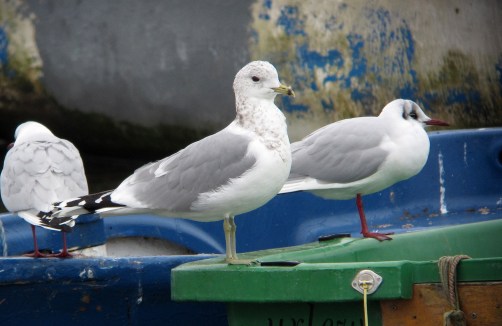
42 Brent Geese, 1
adult winter Mediterranean Gull (probably the first
returning spring bird, especially as today is already
February!!!) 1 Grey Plover.
Mill Pond: 1 Kingfisher (showing very well for long
periods this morning on the wall at the southern end
of the pond - see photo). Just 7 Coot on the pond - I
should make the effort one day to count Slipper and
Peter Ponds to get a definitive total! 2 Mute Swan.
Colour-ringed
Godwits
Christopher
Evans sent me another photo of the colour-ringed
Black-tailed Godwits that he saw at Hayling Oysterbeds
yesterday. This photo showed more clearly the colour
of the rings on the two birds which I think are Y+LO
(and not Y+LR as reported previously) and W+WL. I have
forwarded Christopher's photos to Pete Potts who I
hope will be able to fill in the history of these
birds. Pete Potts informs me that the Godwit Y+LO is
in L+LO - the left lime ring has become stained an
orange colour, probably from irony deposits in
Icelandic pools.

For
the previous entries go to . . January
1-31